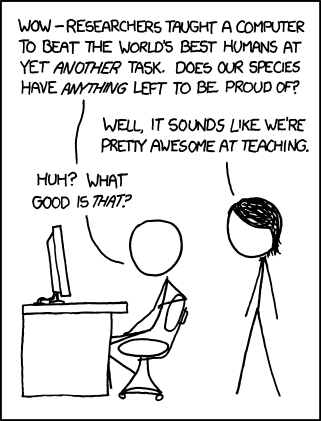 |
| xkcd: 894 |

This is the first visualization I saw of this, from Margaret Mooney. Fisher and Frey are also strongly associated with this idea, and their Google book preview is extensive. I was introduced to this by Dave Coffey (of course) and he has a very nice explanation on his blog. Rather than repeat what he wrote, I'll share what it means to me. Sometimes it's a framework for a single class period, sometimes for an entire course, depending on the scope of the objective.
When I first became a believer in active learning, thanks to the reading provided by Sue Feeley when I was prepping my first math for teachers class, I became very extreme about never telling the students anything. I was proud to hear students pass on asking me questions and work further for themselves. On student evaluations, I took their comments about frustration as statements that this kind of learning was new to them. And I do think that's partially true. But one day when a student said, "why are you asking him, you know he won't answer..." it sounded more like I was denying my students support they needed. I realized that their telling me they were frustrated was because they were frustrated. (Crazy, I know.) And humans can't learn when they are frustrated.
What was missing was demonstration. I had stopped equipping my students for tasks because I equated it with telling. What the literacy education reading let me in on was the idea of a think aloud. Authentically sharing your thinking. But the key for me was the idea that while you're doing this, the students are active observers. You let them know what to watch for and debrief them on what they saw in your demonstration. They are still active! But they may need demonstrations on how to be observers. Early on in a class you might hear me say things like, "Oh. I hoped you'd notice how I..." Or just share my own observations. This is particularly relevant in math ed classes, but I use the idea and technique in content classes, too. Hopefully the demonstrations decrease in frequency and duration during a course.
The next phase for me I typically am too quick with, I think. Whole class work where I solicit ideas and suggestions from the class. It's a bit close to my novice teaching style for comfort, so I think I under use it. You can often gauge in a demonstration when students want more responsibility, or when you've seen some developing use of your objective process. The positive reason I skip more quickly to whole class-students lead-I support is because I want students to have the experience of trying without knowing how. If they can get used to that feeling of 'maybe I could...' it will make them so much stronger as problem-solvers. You can also do this phase in groups with active support from you, and I think this is easier with heterogenous groups.
This just makes so much sense to me as a structure, I sometimes feel guilty for having to be shown it. Of course I want my students to be independent, and of course they need to see and experience what I'm asking them to learn and of course there is an inbetween. Gradual Release also helps me keep focused on those big goals that I want the most, the problem solving and communication. It helps me with instruction because I better know what kind of responses are available for where I assess a student to be. A few classes have gotten to the point where they knew this for themselves; "could we get a demonstration of this?" That's an awesome place to be.






Since I've started my teacher assisting semester, I have been contemplating the many aspects of a teacher's supportive role. On the opposite end of the spectrum, I feel that my students' learning was hindered in the first 2 weeks of school because of my role as 1 of the 3 (sometimes 4) teachers in a room of 26 students. I found myself babying the students, rushing over whenever a hand was raised, and answering questions very explicitly. It took a few days of this for me to realize (a) WHOA! This is NOT how I learned to teach (b) HELLO! This is not fair to my students. My students weren't frustrated, but they weren't learning either.
ReplyDeleteRevisiting this graph is a great reminder of the gradual release of a teacher's support, or a shift in the way a teacher supports. I like your thought on the effectiveness of a quick transition to "students lead-teacher supports". I have often wrestled with the question "How do I teach my students how to become better problem solvers?" What I've found is that as much as I can show them my own strategies for any given problem, my students deserve the opportunity for me to step aside and allow them to think on their own, find a method to try, execute it, modify it, and reflect on it. The more time I spend in the classroom, the more alive this "transitional balance" becomes.
Great post, John. Thanks for sharing!